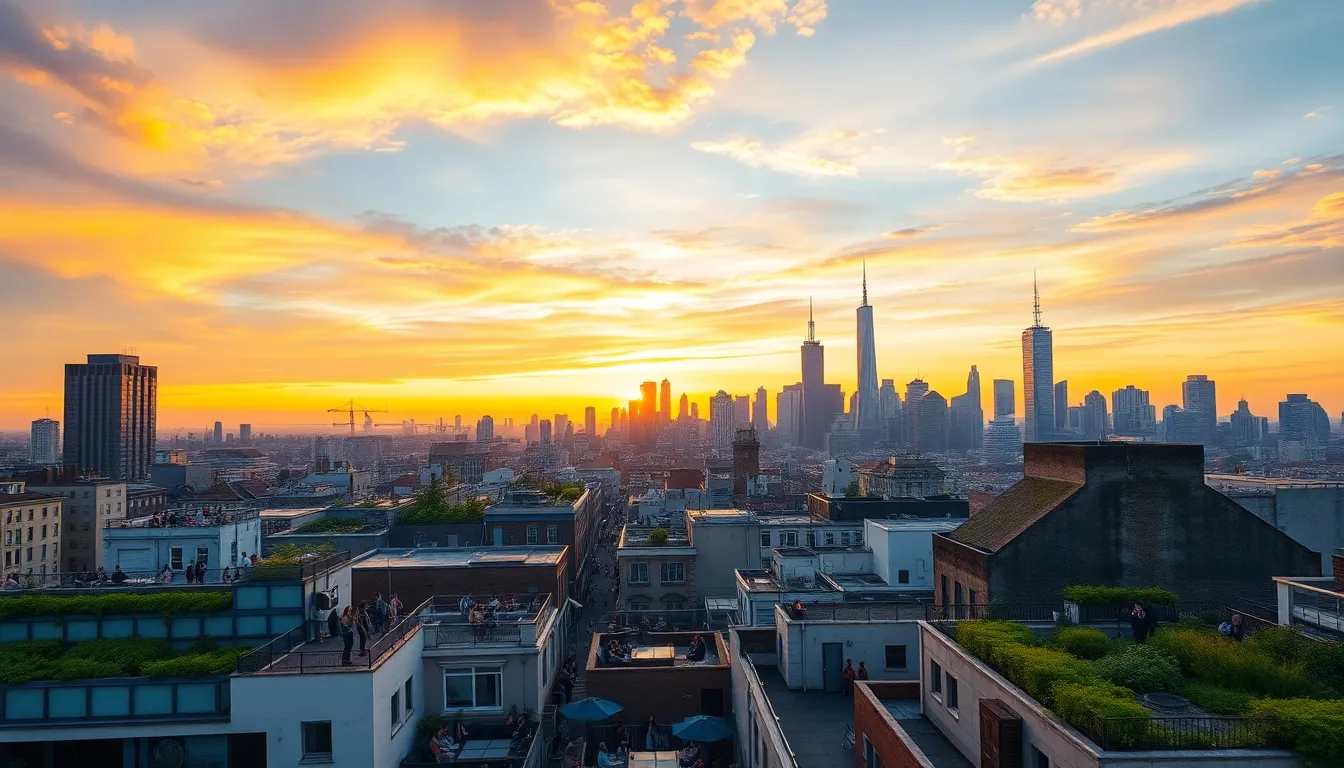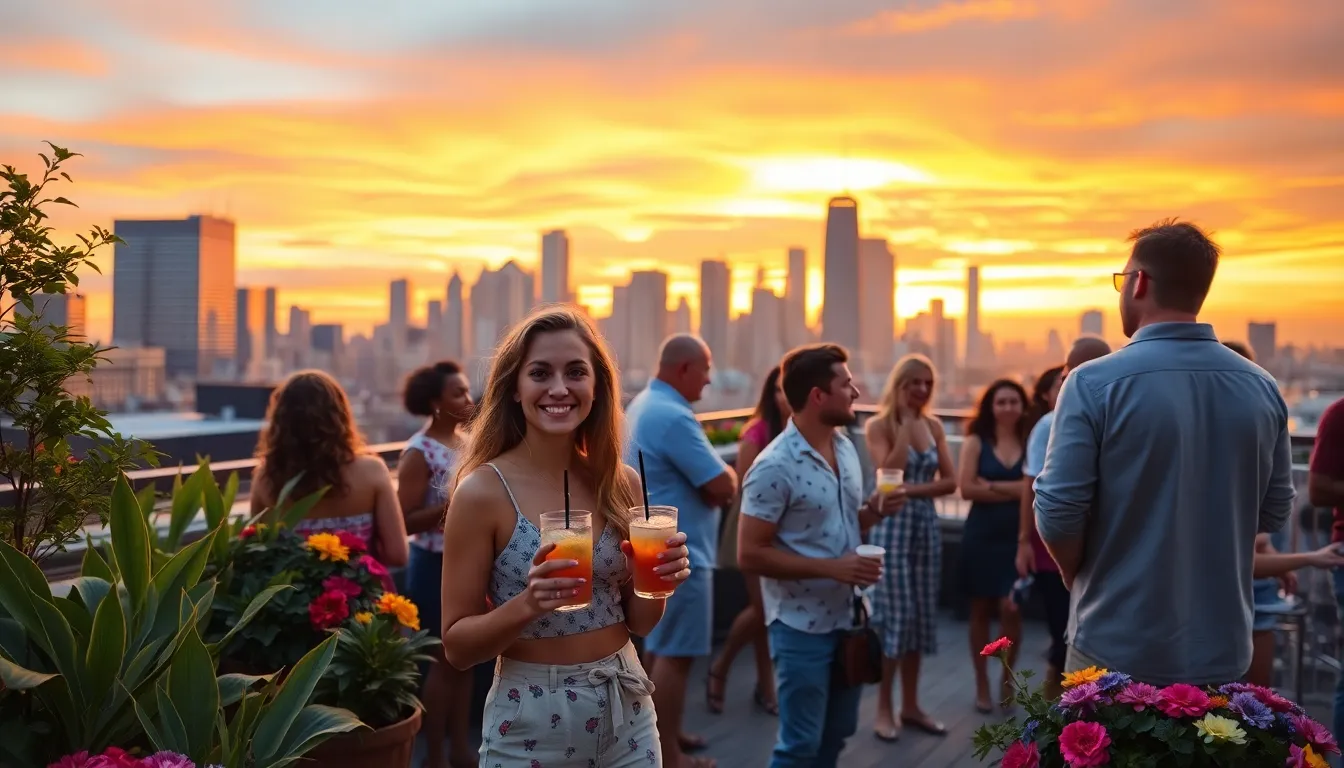City skyline rooftops are the unsung heroes of urban landscapes. They’re not just the tops of buildings; they’re the ultimate vantage points for breathtaking views and unforgettable experiences. Imagine sipping a cocktail while soaking in the sunset over a sprawling cityscape. It’s like a postcard come to life, minus the cheesy tourist traps.
These rooftops offer more than just a pretty view. They’re spaces for social gatherings, rooftop gardens, and even pop-up events that bring communities together. Whether it’s a rooftop bar buzzing with laughter or a serene garden oasis, these elevated retreats transform mundane concrete jungles into vibrant hubs of activity. So, why settle for the ground level when the sky’s the limit? Get ready to explore the captivating world of city skyline rooftops and discover why they’re the hottest spots in town.
Table of Contents
ToggleOverview of City Skyline Rooftops
City skyline rooftops play a vital role in enhancing urban landscapes. These elevated spaces provide stunning views that attract both locals and tourists. Visitors often find themselves captivated by the picturesque panoramas accessed from rooftops.
Rooftop venues serve multiple purposes, acting as sites for social gatherings like parties or weddings, and they draw crowds during events and celebrations. Not only do these rooftops host lively atmospheres, but they also contribute to community building by fostering connections among residents.
Rooftop gardens represent another important aspect, bringing greenery into concrete jungles. These gardens enhance biodiversity, promote mental well-being, and improve air quality. By incorporating nature into urban settings, city skyline rooftops create serene escapes from the hustle and bustle below.
Design considerations also play a significant role in developing these rooftops. Clever architectural features optimize space, allowing for multifunctional areas like lounges, bars, or dining spots. Thoughtful design attracts people seeking unique experiences unavailable on lower levels.
Various cities worldwide embrace rooftop innovation. Examples include New York’s High Line and Chicago’s Rooftop Terrace. Both demonstrate how cities can creatively utilize rooftops to deliver exceptional experiences while enhancing neighborhood aesthetics.
City skyline rooftops undeniably enrich urban environments. They provide opportunities for leisure, relaxation, and exploration. By transforming plain rooftops into vibrant, functional spaces, cities can elevate their appeal to residents and visitors alike.
Architectural Significance

City skyline rooftops possess architectural significance that extends beyond aesthetics. They contribute to urban identity while also serving functional purposes.
Design Elements
Creative design elements make rooftops vital parts of city skylines. Varied materials such as wood, glass, and metal influence the visual impact. Innovative features like green walls enhance biodiversity and promote sustainability. Balconies and terraces offer panoramic views, enhancing the user experience. An emphasis on functionality can transform rooftops into venues for gatherings or leisure. Incorporating lighting designs creates inviting atmospheres during nighttime as well.
Historical Context
Historically, rooftops reflect the evolution of architectural styles and urban planning. Early city designs emphasized practicality, while modern approaches prioritize community engagement. Notable structures like the Flatiron Building in New York set precedents for rooftop usage. Changes in zoning laws during the 20th century encouraged the development of rooftop gardens and entertainment spaces. This trend aligns with growing urbanization, showcasing cities’ adaptability. Rooftops have shifted from mere rooftops to significant social and recreational spaces.
Popular City Skyline Rooftops
City skyline rooftops capture the imagination, showcasing breathtaking views and unique venues for socializing. Their global presence ranges from iconic landmarks to trendy eateries.
Iconic Rooftops Worldwide
Famous rooftops dot major cities across the globe. The Empire State Building in New York offers panoramic views of the city skyline. Tokyo’s Skytree stands tall, providing breathtaking 360-degree vistas. The London Eye features a unique perspective of London’s historic landmarks. Sydney’s Opera House presents a picturesque view of the harbor, attracting countless visitors. Also, the Burj Khalifa in Dubai, the tallest building in the world, allows guests to admire the stunning desert landscape.
Rooftop Bars and Restaurants
Rooftop bars and restaurants enhance urban dining experiences. New York’s 230 Fifth Rooftop Bar offers a vibrant setting with stunning skyline backdrops. The Aviary in Chicago combines fine dining with city views, creating a memorable culinary experience. In Los Angeles, Perch blends French cuisine with a rooftop terrace reminiscent of Paris. The Rooftop at The Standard in London boasts a lively atmosphere, perfect for evening gatherings. Each venue embraces the city’s spirit while providing guests with unforgettable sights and flavors.
The Impact of City Skyline Rooftops
City skyline rooftops significantly shape urban environments, offering both aesthetic appeal and functional benefits. Their influence extends beyond mere visual pleasure.
Urban Aesthetics
Rooftops enhance urban aesthetics by creating dynamic silhouettes against city skylines. They introduce diverse architectural styles, showcasing creativity in design. Unique features like rooftop gardens and lounges complement surrounding buildings, adding layers to the visual landscape. Iconic structures such as the Empire State Building and Tokyo’s Skytree exemplify the potential for rooftops to become integral parts of a city’s identity. These elevated spaces attract photographers and tourists, contributing to a city’s visual narrative.
Environmental Benefits
City skyline rooftops promote environmental benefits that contribute to sustainability. Rooftop gardens improve air quality by filtering pollutants and producing oxygen. They also mitigate urban heat effects through natural insulation. Vegetation enhances biodiversity, providing habitats for various species. These green spaces create serene spots for urban dwellers seeking tranquility amidst busy environments. Furthermore, implementing rainwater harvesting systems on rooftops conserves water, highlighting their role in promoting eco-friendly practices. Enlightened design can transform rooftops into effective solutions for urban ecological issues.
Future Trends in Rooftop Design
Innovative designs are emerging in rooftop landscapes, driven by sustainability and functionality. Green roofs are gaining popularity as urban planners prioritize ecological benefits. These spaces not only enhance biodiversity but also improve air quality.
Smart technologies are increasingly integrated into rooftop designs, allowing for energy-efficient systems. Solar panels and rainwater collection systems are common features, reducing a building’s environmental impact.
Flexibility in use is a key consideration, with many rooftops transforming into multifunctional spaces. Areas dedicated to recreational activities, gardens, and social gatherings promote community engagement. Urban agriculture is also on the rise, encouraging cities to leverage rooftops for food production.
Aesthetic enhancements play a crucial role in attracting visitors to city skylines. Unique architectural elements like cantilevered structures and dynamic lighting create eye-catching profiles against the skyline. Sustainable materials, such as recycled composites, contribute to a more inviting atmosphere.
Collaboration with local artists is becoming a trend, infusing rooftops with creative expressions. Murals and sculptures improve the visual experience, making these spaces more engaging. Rooftop events are expanding, fostering a sense of connectivity among city dwellers.
Cities worldwide are recognizing the significance of rooftop spaces. Examples from New York and Tokyo illustrate how innovative designs can redefine urban experiences. Futuristic concepts are set to prioritize wellness, incorporating elements such as green walls and urban lounges. These evolving trends reflect a shift towards more inclusive and vibrant urban environments.
City skyline rooftops are more than just structures; they’re vibrant spaces that redefine urban living. By blending aesthetics with functionality, these elevated areas foster community connections and offer serene escapes from the bustling city below. As cities continue to evolve, the innovative design and sustainability of rooftops will play a crucial role in shaping urban experiences.
The future of these spaces looks promising with a focus on eco-friendly practices and smart technologies. Rooftops will increasingly serve as multifunctional venues that cater to social, recreational, and environmental needs. Embracing the charm of city skyline rooftops not only enhances urban landscapes but also enriches the lives of those who inhabit them.





